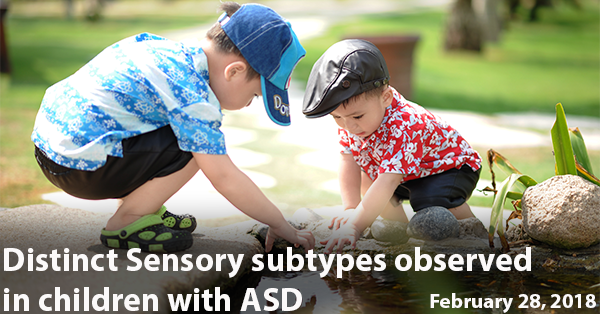Check out other stories from the Latest News
Children with ASD Show Patterned Sensory Behavior
By Chelsea Toledo, M.A. on February 28, 2018

Background: To date, autism is behaviorally diagnosed by trained clinicians using a comprehensive approach that includes systematic and structured observation of a child in the two areas: (1) Social interactions and Communications and (2) Restricted, repetitive patterns of behavior and interests. The range and degree of autism symptoms falls on a continuum, called the autism spectrum. Therefore, both children with severe deficits as well as those who are mildly affected are considered to have Autism Spectrum Disorder (ASD). However, little research has leveraged physiological markers or sensory information to classify ASD subtypes among children.
What’s New: A recent study explored a process for subtyping preschool aged children based on sensory processing patterns, along with social acumen, communication, motor skills, and adaptive behavior. The study employed a model called latent profile analysis, in which observable variables (such as scores on the Short Sensory Profile) are related to hidden variables (such as an underlying sensory subtype). After analyzing data from 400 children with ASD between the ages of 3 and 6, the researchers were able to define four subtypes:
- Sensorimotor – The largest subtype identified, this group had high scores in taste-smell sensitivity and sensory seeking, and was under-reactive to sensory stimuli such as heat or sound (hypo-responsivity). Compared to the other groups, this subtype was characterized by decreased language, social, and adaptive behavior skills. The average age of children in this group was 4 years old.
- Selective Complex – Like the Sensorimotor group, this subtype was characterized by sensory seeking, hyporesponsivity, and decreased language and social skills. However, developments varied among this group, with higher motor skills overall. The average age of children in this group was 4.5 years old.
- Perceptive-Adaptable – Children in this group showed similar patterns to those in the Selective Complex group – with high scores for motor skills and low scores for social acumen and language. However, the children in this group scored higher in those categories overall, as well as in adaptive behavior. The average age of children in this group was 4 years old.
- Vigilant-Engaged – The smallest subtype identified, this group had the hghest developmental skills, with high scores for language, adaptive behavior, and social acumen. They had increased sesntivity in auditory-visual stimuli, as well as taste and smell. This was the oldest group, with an average age of just over 4.5 years.
Why it’s important: This study explored a holistic method for sub-typing children with ASD – which could one day have implications on treatment and shed light on the disorder’s underlying cause. However, considering the groups differed significantly by age, these patterns should be researched further to define subtypes more concretely.
Help me understand :
| Source(s) : |
| Tweet |

